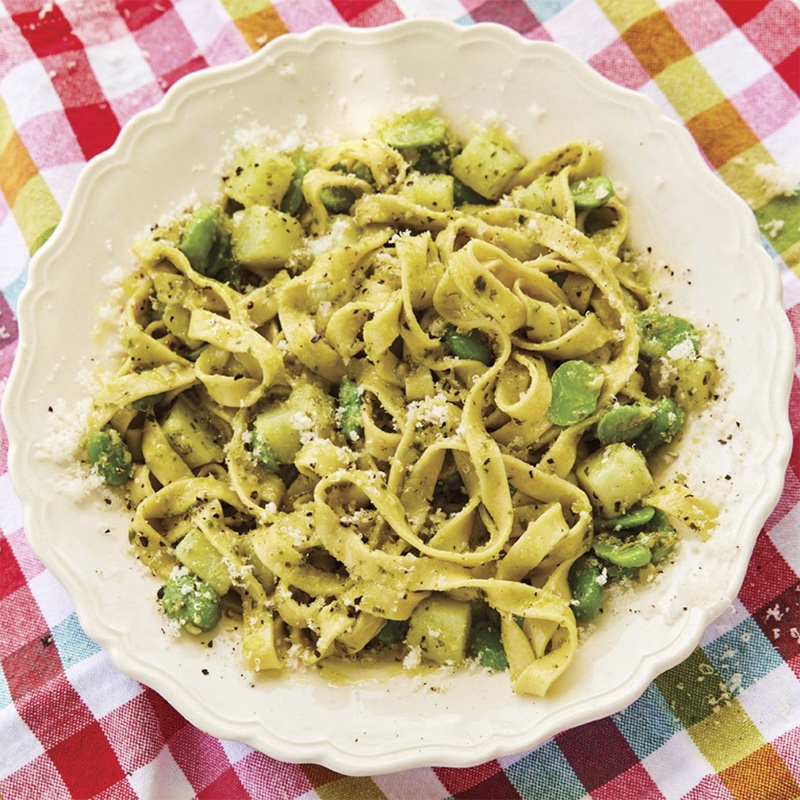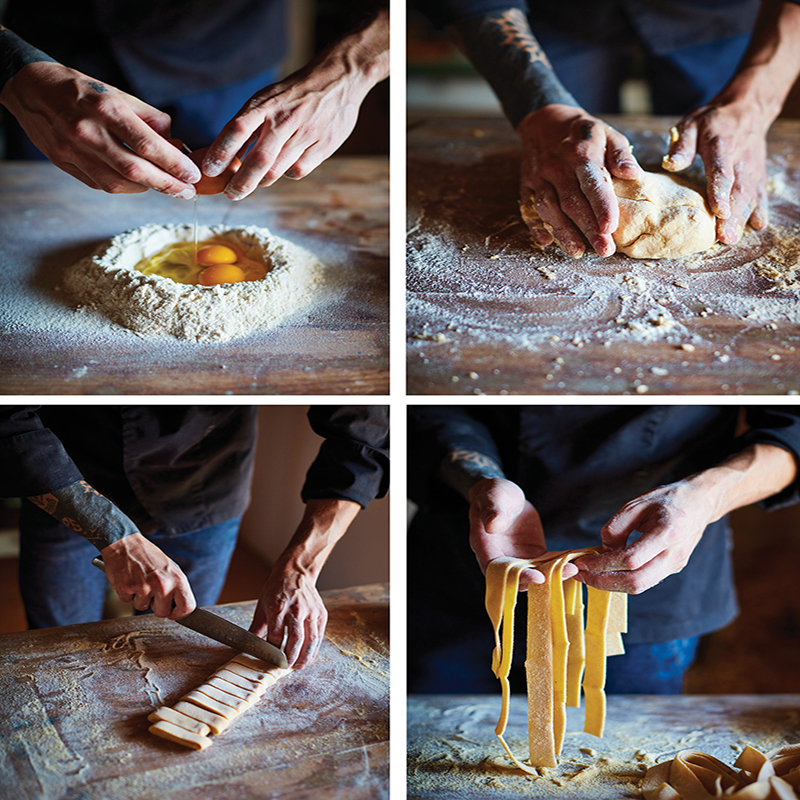
Is there any food more comforting this time of year than a heaping bowl of warm pasta? Whether you’re snacking on mac and cheese after a long day or sharing lasagna with the family on Sunday night, there’s something about the taste and texture of pasta that warms our heart and fills our belly.
Sure, it’s easy to boil a box of penne from the grocery store—but there’s something special about a dish made entirely from scratch. The following recipe for homemade tagliatelle with fresh fava beans and potatoes, from At the Table of La Fortezza by Annette Joseph (Rizzoli 2022), will surely satisfy your party. The dish, including the pasta and pesto, is easy to make and is perfect to serve on a cold winter day.
Basic Egg Dough Pasta
Makes 4 servings
Ingredients
- 1½ cups all-purpose flour, plus more for dusting
- ½ tsp. salt
- 2 large eggs, plus 4 egg yolks
- semolina or corn flour, for tossing

Directions
Sift the flour and salt into a large mixing bowl. Make a well in the middle of the flour, add the eggs and whisk them into the flour with a fork, gradually incorporating the walls of the flour into the well to form the dough. Turn it out onto a lightly floured work surface and knead the dough for 5 to 10 minutes, until it is smooth. Wrap the dough in plastic wrap, and refrigerate at least 30 minutes, or up to 4 hours, before rolling out—any longer and you risk the dough oxidizing and turning a dark color.
With a pasta machine: Set the pasta machine rollers on their widest setting. Cut the pasta dough into quarters. Lightly dust one quarter with flour and press it into a rectangle that’s almost the width of the rollers, about 5 inches wide. You’ll want to maintain this width as you roll by trimming the edges with a knife. Cover the remaining three pieces with plastic to keep from drying out.
First, feed the dough through the machine, and fold the dough in half. Repeat twice.
Then adjust the machine, set the rollers one notch thinner each time you roll the dough through until you are rolling the pasta dough on the thinnest setting. Trim the two ends with a knife so that they are straight, and put on a lightly floured surface. Now your dough is ready to shape into many types of pasta.
One tip: When you are rolling out your dough, try to use as little excess flour as possible as the flour will dry out your dough.
Rolling pasta by hand: Dust a wooden board or work surface with 1 tablespoon flour. Unwrap the chilled dough from the plastic wrap and flatten it with a rolling pin. Roll out the dough into a thin round sheet, less than 1/8 inch thick—you should be able to hold the sheet up to light and see the light through it.
Note: To make tagliatelle or pappardelle, cut the pasta sheet into 5-inch-wide strips, then roll each strip like a jelly roll into a 3-by-5-inch-long log. Trim the ends of the roll to make them straight. Cut into strips, depending on what type of pasta you’re forming, starting on the right side of the log. Then toss the circles of pasta nests into semolina or corn flour, unfurling them into pasta nests. Continue down the log until you have 5 or 6 nests.
Homemade Tagliatelle with Fresh Fava Beans and Potatoes Tossed in Pesto
Serves 4
Ingredients
- basic egg pasta dough
- 3 heaping Tbs. pesto (see below)
- 2 cups fresh fava beans (2 lbs. of pods), cleaned
- ½ tsp. salt, plus ¼ cup for cooking the pasta
- 1 lb. Yukon Gold potatoes, peeled and cut into bite-size cubes (about 2 cups)
- ½ cup freshly grated Parmesan cheese
- ½ tsp. freshly ground black pepper
For the pesto
Makes 6 to 8 cups
- 4 cups loosely packed fresh basil leaves, plus more for garnish
- ½ cup pine nuts, untoasted
- ½ cup grated Parmesan cheese
- 2 cloves garlic (optional)
- 1 tsp. salt
- ¾ cup extra virgin olive oil
Directions
Make the pasta dough and refrigerate.
To make the pesto, combine 4 cups basil, the pine nuts, cheese, garlic (if using) and salt in the bowl of a food processor fitted with the metal blade. Pulse until a paste forms, stopping often to scrape down the sides. Be careful not to overprocess, as the heat tends to cook the basil and brown the leaves. Pour the oil into the mixture and blend until smooth.
This can be made 1 day ahead and refrigerated in a lidded container. Stored in a sealed jar, it can last 2 weeks in the refrigerator.
To make the tagliatelle, remove the beans from the pod by pulling a thread that peels back on the curved side of the pod to release the beans inside. The beans have an outer skin that must be loosened. Place the beans into boiling water for 3 minutes. Drain and cool the beans for about 5 minutes, then remove the outer skin to reveal the fava beans that are now ready to cook.
In a medium pot filled one-half full of water, add ½ teaspoon salt and bring to a boil over medium-high heat. Add the beans, and blanch for 5 minutes, or until they are tender to the bite. Remove with a slotted spoon and set aside. In the same pot, add the potatoes and cook for about 10 to 12 minutes, until tender. Remove with a slotted spoon and set aside.
Remove the pasta dough from the refrigerator, roll it out and cut the pasta sheet into 5-inch-wide strips, then roll each strip like a jellyroll into a 3-inch-long log. Trim the ends of the roll to make them straight. Cut into ¼-inch-wide strips, starting on the right side of the log. Then toss the circles of pasta nests into semolina or corn flour, unfurling them into pasta nests. Continue down each log until you have 5 or 6 nests.
Fill a large pot three-quarters full of water, add ¼ cup salt and bring to a rolling boil over high heat. Add the pasta and cook about 5 minutes, until al dente. Drain.
In a large serving bowl, scoop the pesto, then add the drained pasta, then the beans and potatoes, and gently toss to combine. Top with grated Parmesan, season with freshly ground pepper and serve immediately
Recipes and photos © At the Table of La Fortezza by Annette Joseph, Rizzoli New York, 2022. Photographs © David Loftus.